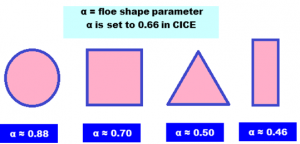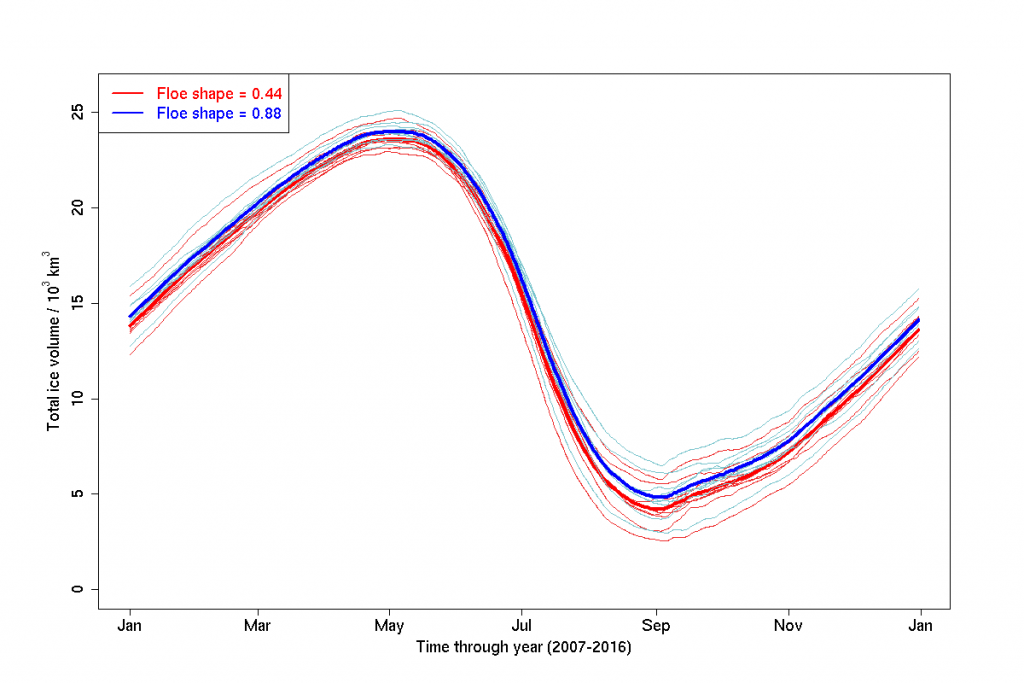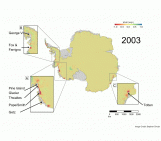
Figure 1: Annual evolution of the sea ice area with two different floe shape parameters of 0.44 (red) and 0.88 (blue). The model is spun-up between 2000 – 2006 and then evaluated for a further ten years between 2007 – 2016 and the mean values over this period displayed by the thick lines. Thin lines show the results for individual years. [Credit: Adam Bateson]
Polar sea ice exists as isolated units of ice that we describe as floes. These floes do not have a constant shape (see here for instance); they can vary from almost circular to being jagged and rectangular. However, sea ice models currently assume that all floes have the same shape. Much focus has been paid to the size of floes recently, but do we also need to reconsider how floe shape is treated in models?
Why might floe shape matter?
In recent years, sea ice models have started to examine more and more how individual floes influence the overall evolution of sea ice.
A particular focus has been the size of floes (see here and here) and the parameterisation of processes which influence floe size (see here for example). However less attention has been given to the shape of the floe. The shape of the floe is important for several reasons:
- Lateral melt rate: the lateral melt rate describes how quickly a floe melts from its sides. Two floes with the same area but different shape can have a different perimeter; the lateral melt rate is proportional to the floe perimeter.
- Wave propagation: a straight floe edge will impact propagating waves differently to a curved or jagged floe edge. The distance waves travel under the sea ice and hence the extent of sea ice that waves can fragment will be dependent on these wave-floe edge interactions.
- Floe mechanics: an elongated floe (i.e. much longer in one direction than another) will be more likely to break from incoming waves if its longer edge is aligned with the direction the waves are travelling.
How do models currently treat floe shape?
One approach used within sea ice models to define floe shape is the use is the use of a parameter, α. The smaller the floe shape parameter, the longer the floe perimeter (and hence, the higher the lateral melt rate). A standard value used for the parameter is 0.66 (Steele, 1992). Figure 2 shows how this floe shape parameter varies for some common shapes.

Figure 2: The floe shape parameters for some common shapes are given for comparison to the standard value of 0.66. [Credit: Adam Bateson]
The standard value of the floe shape parameter, 0.66, was obtained from taking the mean floe shape parameter measured over all floes greater than 1 km from a singular study area of 110 km x 95 km at one snapshot in time. Despite the limited data set used to estimate this shape parameter, it is being used for all sea ice throughout the year for all floe sizes. However, this would only be a concern to the accuracy of modelling if it turns out that sea ice evolution in models is sensitive to the floe shape parameter.
Model sensitivity to floe shape
To investigate the model sensitivity to the floe shape parameter two simulations have been run: one uses a floe shape parameter of 0.88 and the other uses 0.44, chosen to represent likely extremes. The two simulations are run from 2000 – 2016, with 2000 – 2006 used as a spin-up period. Figure 1 displays the mean total ice area throughout the year and results of individual years for each simulation. Figure 3 is an equivalent plot to show the annual evolution of total ice volume for each simulation.
The results show that the perturbation from reducing the floe shape parameter is smaller than the variation between years within the same simulation. However, the model does show a permanent reduction in volume throughout the year and a 10 – 20 % reduction in the September sea ice minimum. The impact of the floe shape is hence small but significant, particularly for predicting the annual minimum sea ice extent and volume.

Figure 3: Annual evolution of the sea ice volume with two different floe shape parameters of 0.44 (red) and 0.88 (blue). The model is spun-up between 2000 – 2006 and then evaluated for a further ten years between 2007 – 2016 and the mean values over this period displayed by the thick lines. Thin lines show the results for individual years.
More recent studies on floe shape
In 2015, Gherardi and Lagomarsino analysed the floe shape behaviour from four separate samples of satellite imagery from both the Arctic and Antarctic. The study found different distributions of floe shapes in different locations, however there was no correlation between floe shape and size. This property would allow models to treat floe shape and size as independent properties. More recently, in 2018, Herman et al. analysed the results of laboratory experiments of ice breaking by waves. It was found that wave break-up influenced the shape of the floes, tending to produce straight edges and sharp angles. These features are associated with a smaller floe parameter i.e. would produce an increased lateral melt rate.
What next?
More observations are needed to identify whether the use of a constant floe shape parameter is justified. The following questions are important:
- Do further observations support the finding that floe size and shape are uncorrelated?
- What range of values for the floe shape parameter can be observed in reality?
- Do we see significant variations in the floe shape parameter between locations?
- Do these variations occur over a large enough scale that they can be represented within existing model resolutions?
Further reading
- Gherardi, M. and Lagomarsino, M.C., 2015. Characterizing the size and shape of sea ice floes. Scientific reports, 5, p.10226.
- Herman, A., Evers, K.U. and Reimer, N., 2018. Floe-size distributions in laboratory ice broken by waves. The Cryosphere, 12(2), pp.685-699.
- Steele, M., 1992. Sea ice melting and floe geometry in a simple ice‐ocean model. Journal of Geophysical Research: Oceans, 97(C11), pp.17729-17738.
Edited by Violaine Coulon and Sophie Berger
 Adam Bateson is a PhD student at the University of Reading (United Kingdom), working with Danny Feltham. His project involves investigating the fragmentation and melting of the Arctic seasonal sea-ice cover, specifically improving the representation of relevant processes within sea-ice models. In particular he is looking at lateral melting and wave induced fragmentation of sea-ice as drivers of break up, as well as the role of the ocean mixed layer as either an amplifier or dampener to the impacts of particular processes. Contact: a.w.bateson@pgr.reading.ac.uk or @a_w_bateson on twitter.
Adam Bateson is a PhD student at the University of Reading (United Kingdom), working with Danny Feltham. His project involves investigating the fragmentation and melting of the Arctic seasonal sea-ice cover, specifically improving the representation of relevant processes within sea-ice models. In particular he is looking at lateral melting and wave induced fragmentation of sea-ice as drivers of break up, as well as the role of the ocean mixed layer as either an amplifier or dampener to the impacts of particular processes. Contact: a.w.bateson@pgr.reading.ac.uk or @a_w_bateson on twitter.




